Singing the Body Electric: A Conversation with Gogi Saroj Pal
Singing the Body Electric: A Conversation with Gogi Saroj Pal
Singing the Body Electric: A Conversation with Gogi Saroj Pal
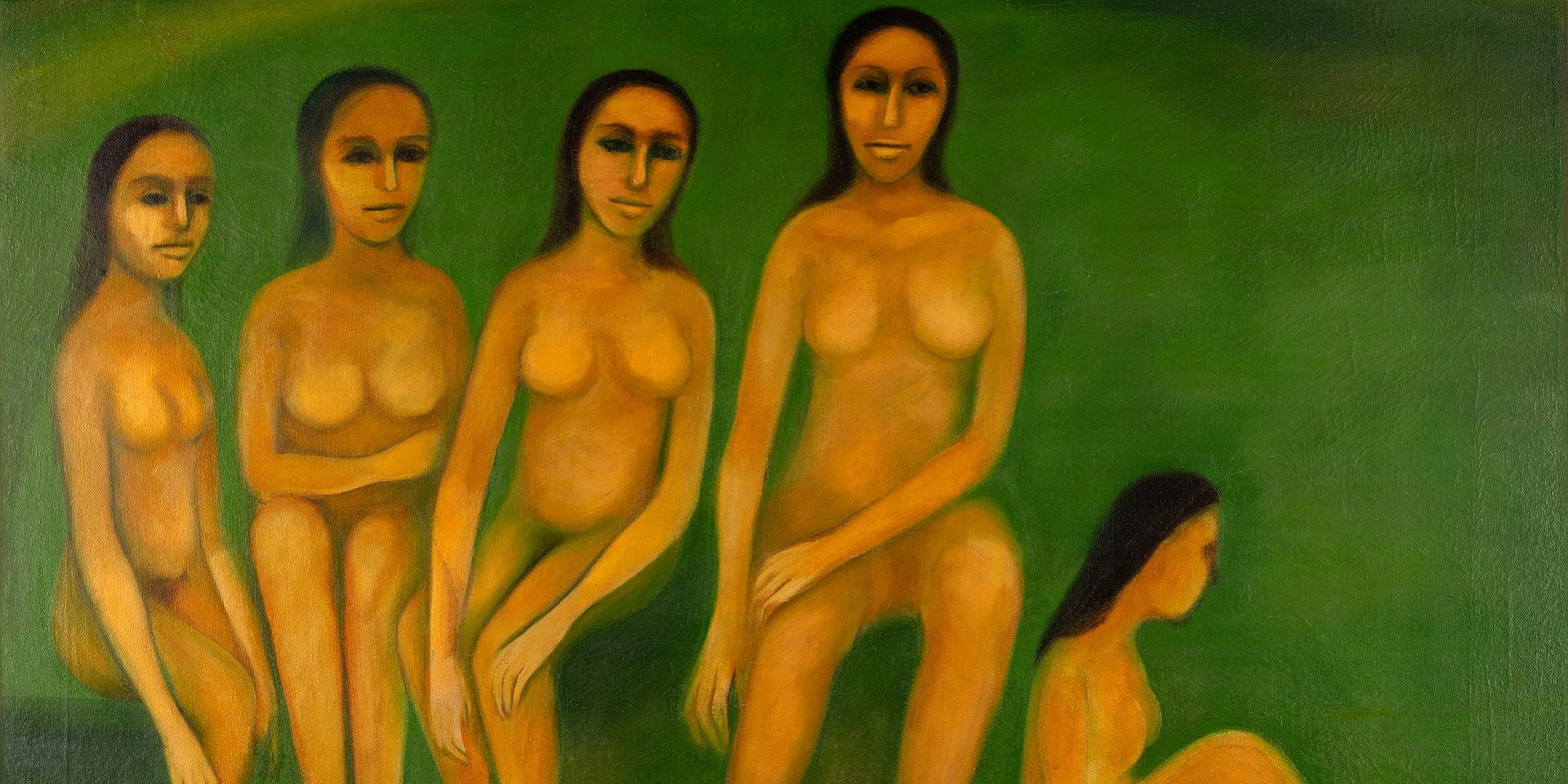
Gogi Saroj Pal, Untitled (detail), Oil on canvas, 38.7 x 50.0 in. Collection: DAG
Gogi Saroj Pal is one of India's most important artists who has led the way towards re-imagining the mythic trope of the female nude in art. Eternally transformative, but grounded in material experience and the feel of sensual pleasure, female bodies and feminine forms are employed by Pal as imaginary canvases where women's fantasies of amorphous self-making meet the world's expectations of conformity.
She started out making still lifes that were taught rigorously at the academic institutions she went to, including the College of Art at Banasthali, Rajasthan, the Government College of Arts and Crafts, Lucknow and New Delhi’s College of Art. Soon enough, however, an artistic personality began to develop that was shaped by her own experiences of migration, memories of childhood—especially stories heard from her liberal grandmother—and an innate playfulness that she often characterizes as a propensity towards creating trouble or ‘gadbad’ that would keep her elders on their toes. This spirit comes across in many of her painted works, where female figures dominate with moods of playfulness, while always suggesting a darker undertow that rests with the act of framing them or looking at them, troubling our own gaze. Myths and stories are a common fund for most Indian artists, but it was especially significant for Pal that her uncle was the Hindi novelist Yashpal, who wrote a famous novel of partition and its despondent aftermath titled Jhoota Sach (translated as This is Not that Dawn); and his presence in the household allowed the young artist to meet some of the great progressive novelists of the post-independent era as well. As she spoke about her family’s migratory roots, it became clear that the hybrid bodies she painted also had their roots in an experience of constant transition and transformation.

Gogi Saroj Pal at her New Delhi residence, near the Garhi Studios. Image courtesy: DAG
She spoke briefly to the editors of the DAG Journal, elaborating on some of the themes she has tackled in her work over a long career that started in the 1960s. What follows are edited excerpts from the conversation.
Q. Since you employ the female nude so plentifully across your work, I wanted to know what your relationship with it is like. Did formal academic training teach you to see the nude in any specific way that helped your art in the future?
Gogi Saroj Pal: When we were taught at the art schools in the 1960s there were two female models that we worked with—a young woman and an elderly one, hired by the College of Art in Delhi. Even though we made studies, I had a very natural relationship with nudity while growing up—as I believe most Indians do. People bathe in the open, wash themselves, so it wasn’t very shocking for me to be exposed to the human body. Sometimes I would help my mother bathe at home—pouring small jugs of water on her, when nobody else was in the house. There was nothing odd about doing that. So it came quite organically into my works and I didn’t think too much about it.
At J. J. (School of Art, Mumbai), however, they would employ models and have them wear petticoats covering up their lower bodies. I found that very odd! How would one make out the legs of the woman if they were covered like that? Besides, if you look at most of the sculptures that are kept in temple complexes, especially in south India, you would see that nudity was not a shocking thing in the past either. Some of our male professors would often use the excuse of ‘teaching the nude’ to make inappropriate advances or suggestions, however I still thought of myself as a child at the time—not quite a woman—so I would enjoy disrupting these demands through sheer childishness and disorderly behaviour.
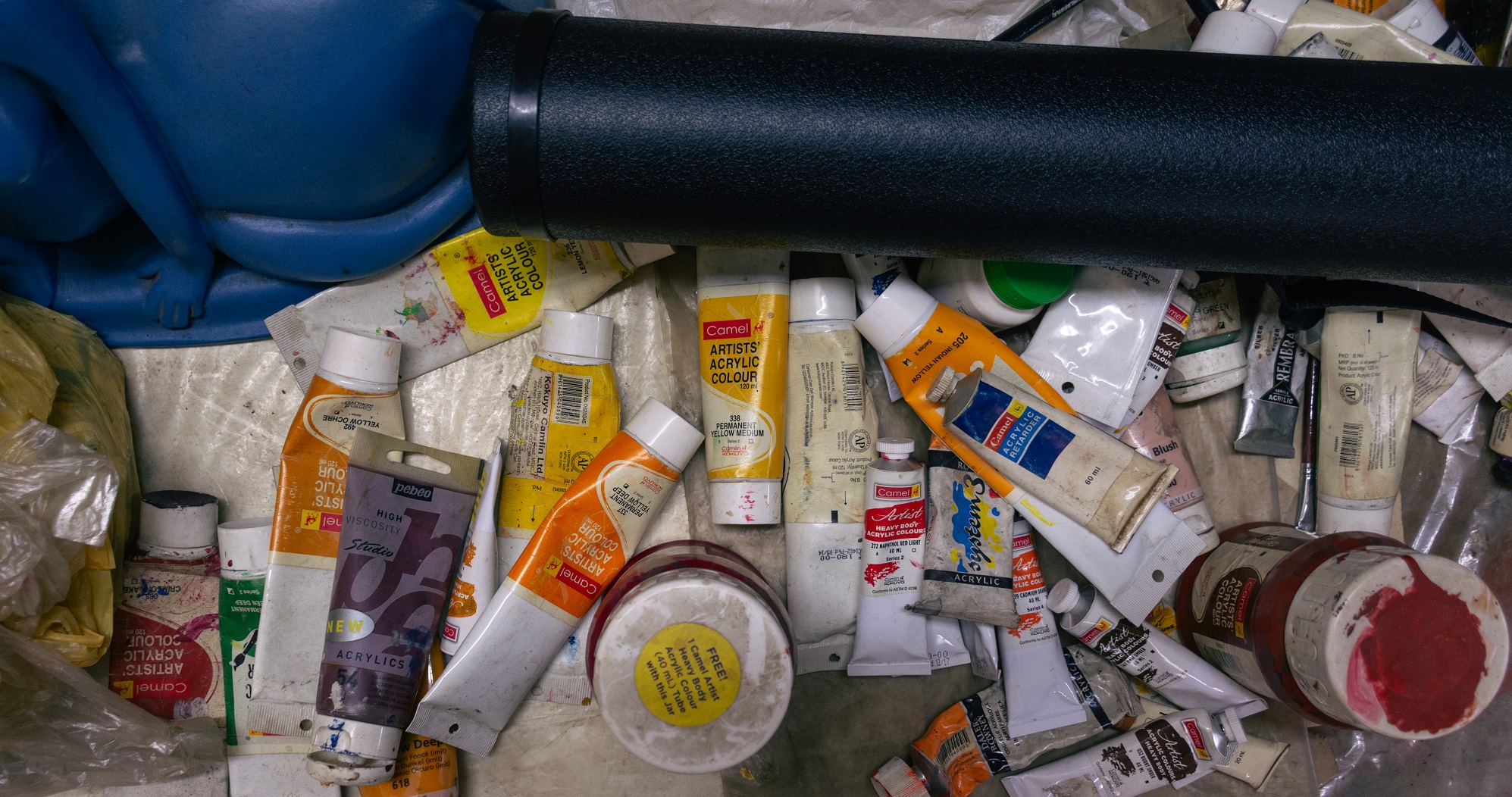
Paint tubes used by artist in her studio. Image courtesy: DAG
Q. How did you come to make your Nayika series of works? Were you always interested in women performers and actors? One of your nayikas is even named Nati Binodini (after a famous female stage actor from the nineteenth and early twentieth centuries in Bengal), while others are reminiscent of the Kalighat sundaris where women performers and courtesans are shown in similar poses—either performing with musical instruments or conducting careful routines of self-care/ grooming.
Gogi: Yes, I was interested in the history of performers like Nati Binodini. When a documentary film was being made on her life (Tuhinabha Majumdar’s Aamar Katha: Story of Binodini, 2015), the director used some of my Nati Binodini paintings in the film as well. Due to my surname, the director thought I was Bengali as well! My grandmother was a rough contemporary of hers—I heard about figures like Binodini from her, among many other stories she told me. She would also make me read many things and she herself was a voracious reader—so it’s possible that I read about her (Binodini) first. I would constantly demand that she tell me stories—including those she had told me many times before. But I was not just interested in the stories themselves. I was invested in how she told them as well. If she missed a particularly dramatic sigh at a point she had used it in an earlier telling I would throw a fit and ask her to repeat it again, with feeling! Thus, how a story is told (or, performed) was important to me from an early age.
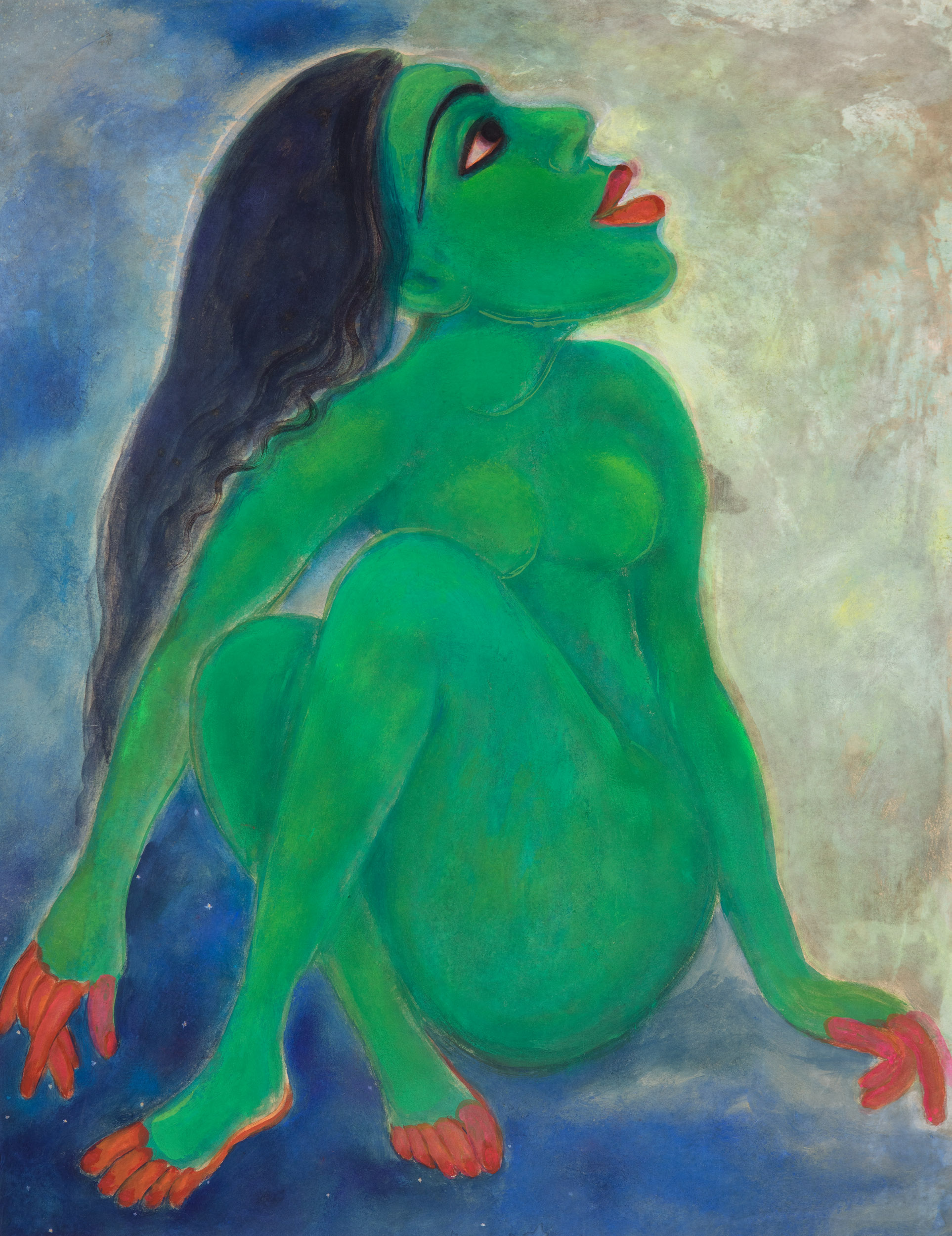
|
Gogi Saroj Pal, Untitled, Watercolour and gouache on paper, 37.2 x 28.5 in., late-1990s. Collection: DAG |
The nayikas have recurred in my work, rather than being a limited series. I’m also interested in using common symbols like the sickle, which empowered female gods often use to commit shocking acts of violence like decapitating someone’s head. I have often used the blood that flows out of these violent acts as a part of my own signature in some works! The hammer is a sign of the industrial revolution but the sickle is an agricultural symbol—going back further in time. It was used by Communists too.
I like to imagine how women look at themselves too. In the 1990s when I started introducing commercial products and commodities in my work on women (often shown using beauty or hygiene products, suggesting a turn towards consumerism) I wanted to see how they were reacting to social changes that allowed certain kinds of freedom (that were not available earlier). I have said this earlier too that as a woman and as an artist I am concerned that people attach labels to my work without realising that it is the issues that I address through my paintings that are more important. Particularly since the issues have not really changed over the years. We still talk of confining women, of punishing people who don’t follow society’s rules. I would be happier if there was some analysis, some understanding, some curiosity even, rather than just acceptance.

Gogi Saroj Pal, Homecoming, Oil and acrylic on canvas pasted on Masonite board, 24.0 x 27.0 in., 1990. Collection: DAG
Q. The ‘relationship’ series of works you made depicted women with pet animals, eventually moving on to another phase of your work where these forms were beginning to merge, drawing from older myths of trans-species iconographies; how did this come about?
Gogi: Mostly from observing how culturally different our relationships to animals are. Sacrificing them is common to most cultures too. I went to Pakistan and discovered that they tend to keep cats at home but not dogs. I was quite surprised to discover this. After all, dogs are famous for their loyalty to humans. People are also cruel to animals; I’ve seen children misbehaving with dogs, even though the dog knows how to behave with a human.
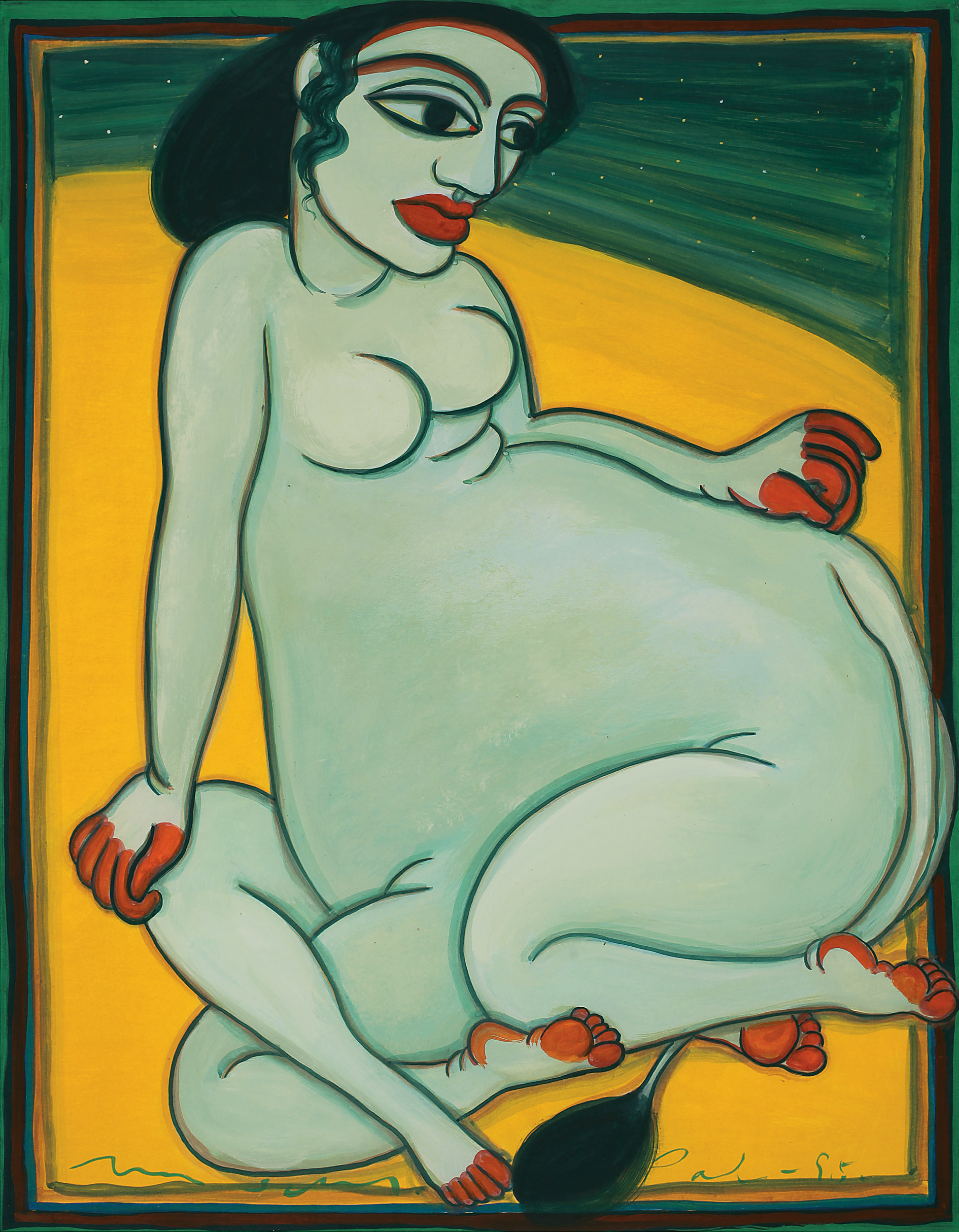
|
Gogi Saroj Pal, Kamdhenu, Gouache on paper, 22.7 x 17.7 in., 1995. Collection: DAG |
I don’t think it’s right to see the hybrid bodies I painted as part of a progression. They were always there; I didn’t really think of doing it in order to extend some idea from an earlier series. These keep recurring, rather than being totally replaced with something new. People in our culture also make constant comparisons of human behaviour with animals. Especially for women—if someone is well-behaved, she is said to be like a cow. I find these fascinating, so I put them in my work, as if to exaggerate the feeling. Of course, I also drew from mythology, where such hybrid human-animal forms recur.
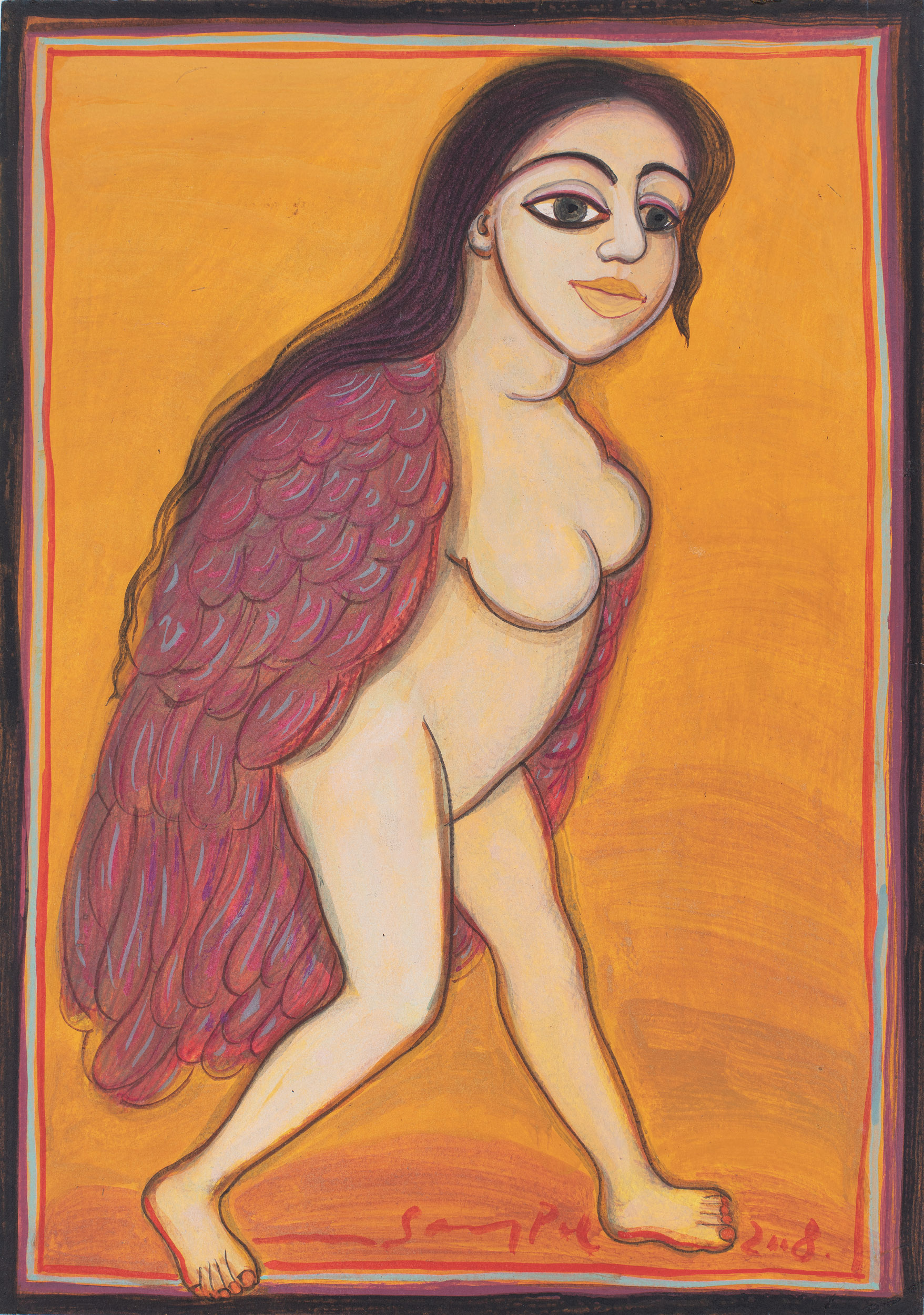
|
Gogi Saroj Pal, Untitled (Kinnari Series), Gouache on paper, 11.2 x 8.0 in., 2008. Collection: DAG |
Q. How did you come to paint some of your other series, like the one on Tibetan monks in Dharamshala, or the Kinnari works? You have spoken about the influence of migration on your work, did these works also express your experience of migrancy in some way?
Gogi: My family has roots in Kangra, Lahore (some having moved to India after the Partition in 1947), Uttar Pradesh and I have lived in New Delhi for several decades now. I still remember stories of perilous river crossings that brought my family members over from higher latitudes. Earlier in my career, and even before that, artists were trying to set up communities and villages in parts of Himachal Pradesh. B. C. Sanyal, for instance, stayed at an arts village near Palampur (Andretta, which was started by the educator, Nora Richards). Some of this land was given to Richards by my uncle—although she claimed later that it was given to her by the British!

B. C. Sanyal, Untitled, Watercolour wash and charcoal on handmade paper, 15.2 x 19.0 in., 1979. Collection: DAG
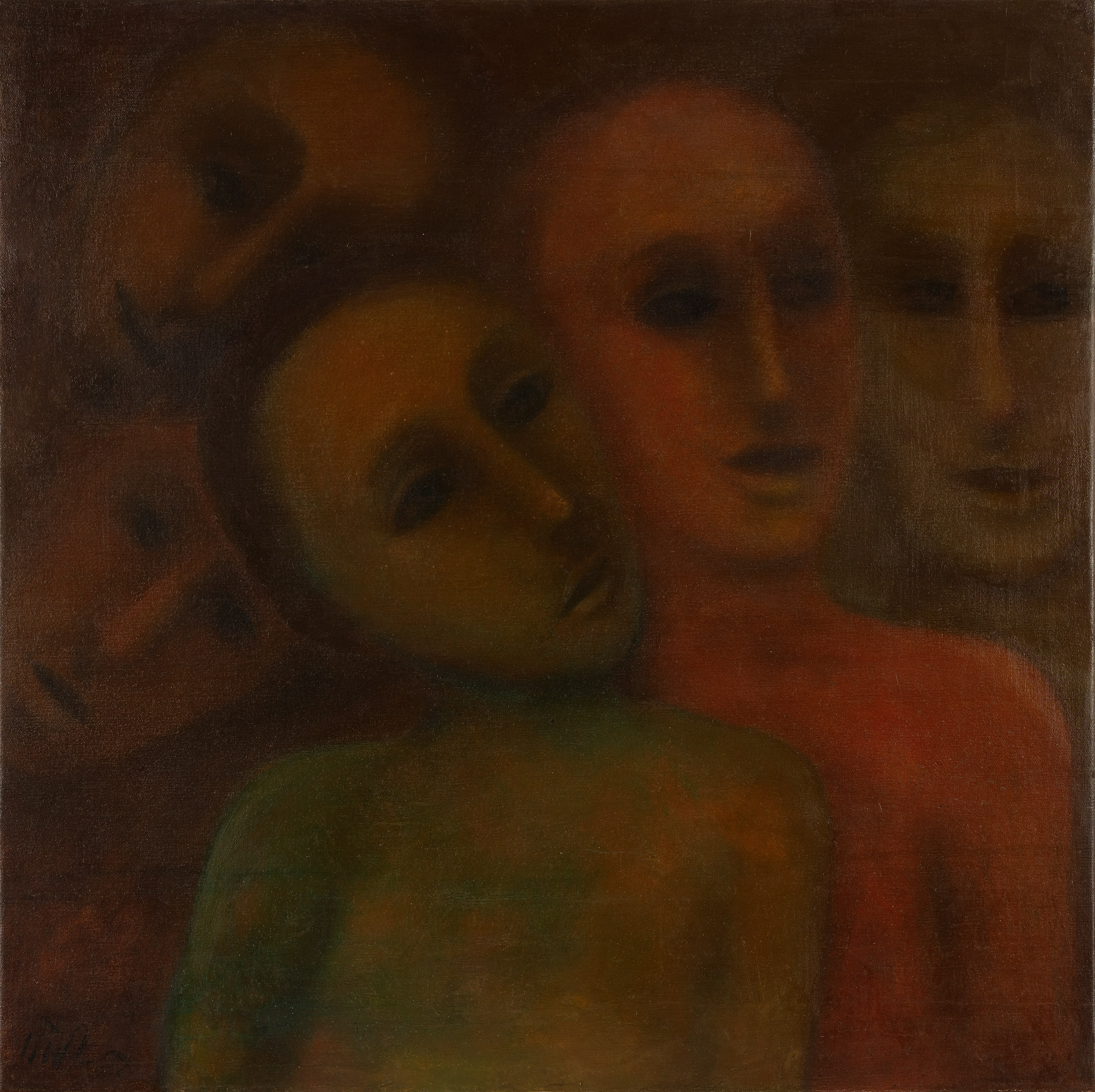
|
Gogi Saroj Pal, Young Monks, Oil on canvas, 24.0 x 24.0 in., 1982. Collection: DAG |
We know these places intimately and were there when the Tibetan refugees and the Dalai Lama came over (to India). When I was growing up in Kangra we would observe religious pilgrims and other kinds of migrants coming into the valley annually. They were usually garbed in yellow, but one day we saw refugees coming in wearing red (referring to the robes of the Tibetan monks). It was as if the landscape itself had changed colour. From the greens and yellows it was now covered in a mournful red. I went to document them several times. Looking at the younger refugees my mother would say that their parents have the same concern for their well-being as we do for our own children.
The Kinnari series was inspired by sculptures I saw in several temples across India. I’m drawn to their description as beings who are neither at home in the sky, nor on earth. They are eternally suspended in space. We are discovering words for these beings, like 'mermaids', through western sources (cartoons, especially) these days, but they have always been with us or around us.
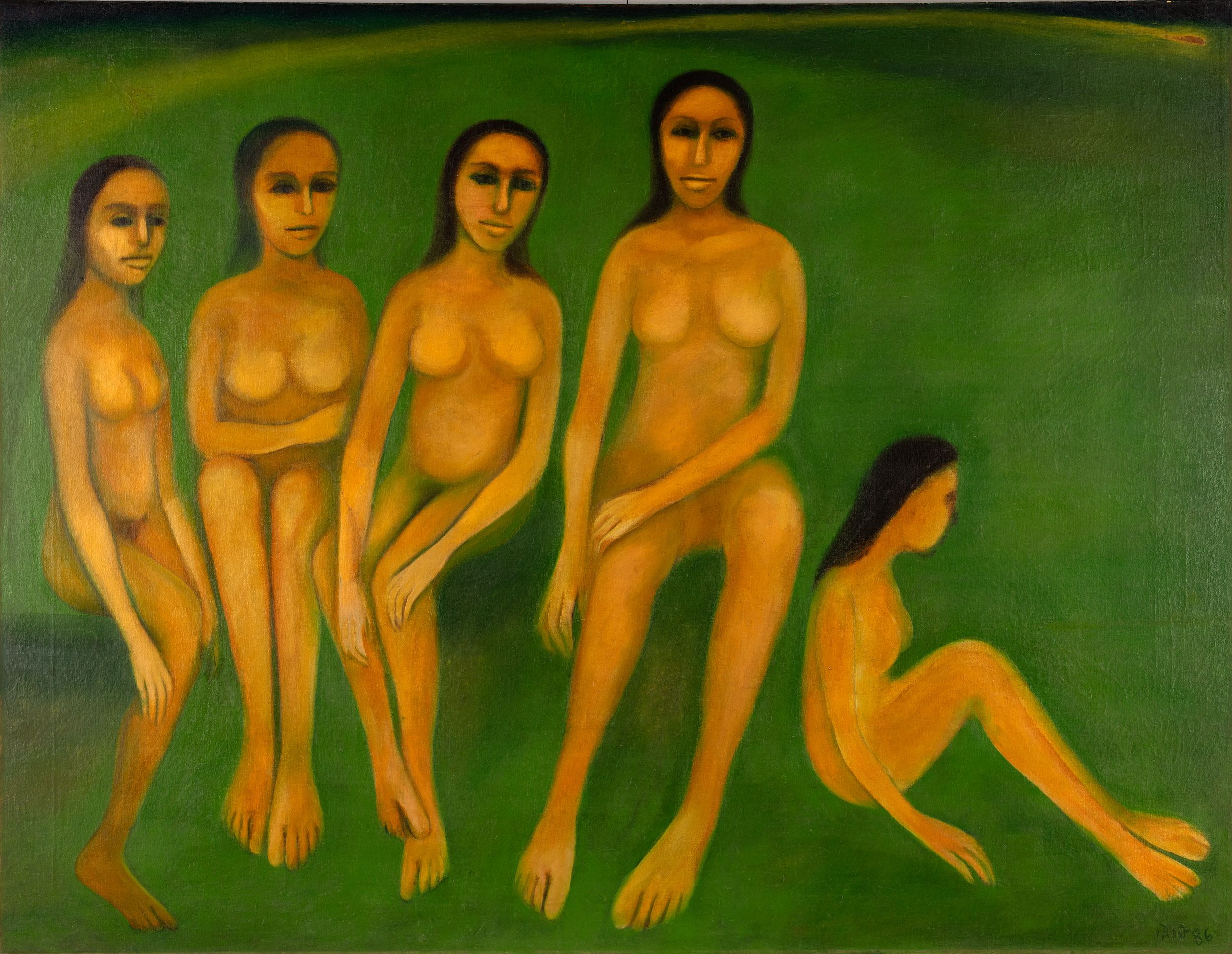
Gogi Saroj Pal, Untitled, Oil on canvas, 38.7 x 50.0 in., 1986. Collection: DAG


